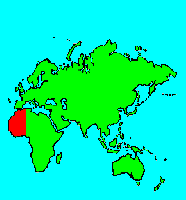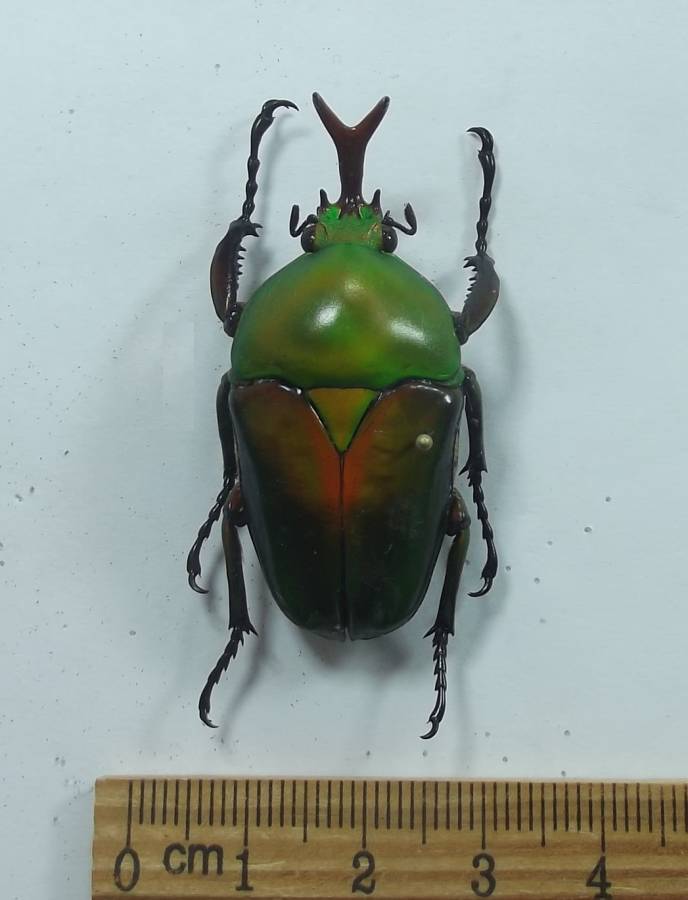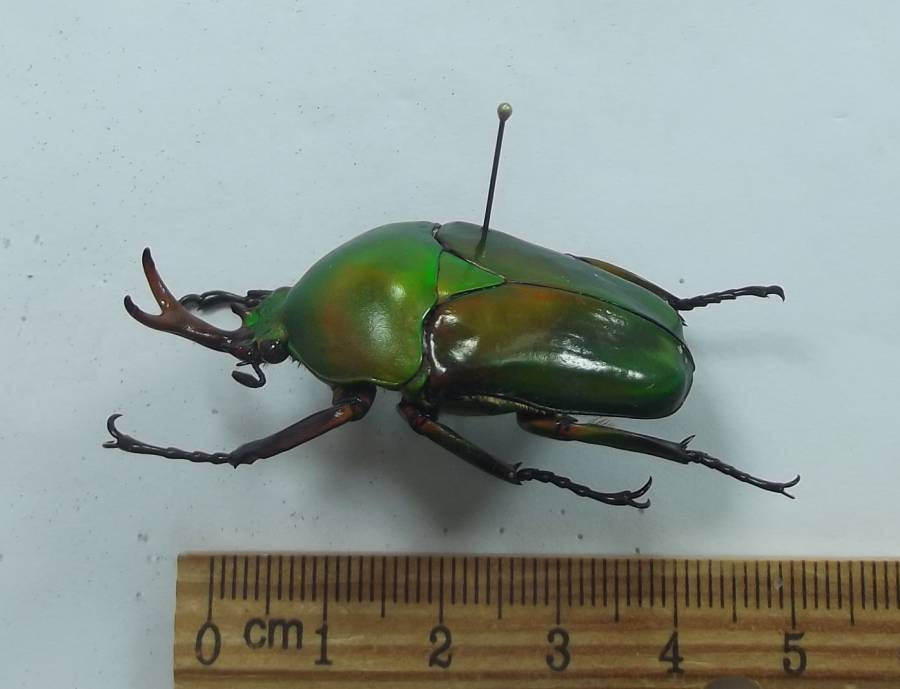SPECIES INFO
Eudicella schultzeorum subspecies pseudowoermanni has four or more very different color forms with intermediates. This particular form has a gold hue when exposed to certain angles of natural sunlight. The challenge with identification is to separate the all green forms of E. morgani and E schultzeorum in Cameroon.Eudicella Genus contains about 16 different species. Following Allard in Sciences Nat they are listed below with their approximate ranges: (An * indicates the 10 species that are pictured herein.)
SPECIES - - - - - - RANGE
E. aethiopica - - - - - Ethiopia
E. colmanti* - (Blunt Tips) - Congo, C. Africa, and Zaire
E. ducalis* - (Giant) - East Zaire
E. euthalia* - - - - - Kenya to Natal
E. frontalis* - (Blunt Tips) - Ivory Coast, Ghana, etc.
E. gralli* - (Wide Fork) - Ivory Coast to Kenya
E. hereroensis* - - - - - Namibia
E. immaculata* - - - - S. Kenya
E. inexpectata - - - - North Congo
E. intermedia - - - - S. Cameroon
E. morgani - - - - Ivory Coast, Ghana, etc.
E. nyassica* - - - - S. Tanzania
E. smithi* - - - - Kivu to Zimbabwe
E. tetraspilota* - - - - Katanga to Burundi
E. trimeni - (Unusual Orange) - Natal to S. Africa
E. woermanni* - (Narrow Fork) - Cameroon to Malawi
All the species of Eudicella share the common feature of a forward pointing male head horn that is forked some distance away from the head. Because of the variation in size and horn development between individuals, it is difficult to separate the species based upon horn size and horn shape. However, E. colmanti and E. frontalis have unusual thickened horns that do not terminate in a sharp point.
Two of the most widespread species, woermanni and gralli, both have multiple color forms which mimic each other in selected portions of their ranges. For example, both E. gralli gralli and E. woermanni woermanni have solid green forms, and E. gralli gralli and E. woermanni pogei have striped forms. These two species both also contain spotted forms. The way to separate the two species is not based on color patterns, but that E. gralli has a very wide forked horn, and E. woermanni has a forked horn with smaller less diverging branches.
We have included among aothers the following genera in this group of African goliath beetles:
Amaurodes
Astenorrhina
Ceratorhina
Cheirolasia
Coelorrhina
Eudicella
Megallorrhina
Neptunides
Ranzania
Taurrhina
Beetles (Order Coleoptera) are a diverse group of insects found throughout the world. They usually can fly and typically have four wings. Two of the wings are hardened (elytra) and serve as a body cover to protect the flying wings and abdomen. Beetles begin their life as a larvae or grub that goes through a metamorphosis that turns this worm-like creature into an adult with six legs and four wings. There probably are over 500,000 species of beetles in the world. However, that number is only conjecture as the United States does not have a complete list of its known species.
The United States has relatively few exotic beetles. However, countries like Brazil, Mexico, Ghana, Zaire, Malaysia, and Peru have many beautiful beetles.
Exotic beetles are such a fascination in Europe and Japan that they are collected much as coins are collected throughout the rest of the world.
Insects (Class Insecta) are the most successful animals on Earth if success is measured by the number of species or the total number of living organisms. This class contains more than a million species, of which North America has approximately 100,000. (Recent estimates place the number of worldwide species at four to six million.)
Insects have an exoskeleton. The body is divided into three parts. The foremost part, the head, usually bears two antennae. The middle part, the thorax, has six legs and usually four wings. The last part, the abdomen, is used for breathing and reproduction.
Although different taxonomists divide the insects differently, about thirty-five different orders are included in most of the systems.
The following abbreviated list identifies some common orders of the many different orders of insects discussed herein:
Odonata: - Dragon and Damsel Flies
Orthoptera: - Grasshoppers and Mantids
Homoptera: - Cicadas and Misc. Hoppers
Diptera: - Flies and Mosquitoes
Hymenoptera: - Ants, Wasps, and Bees
Lepidoptera: - Butterflies and Moths
Coleoptera: - Beetles
Jointed Legged Animals (Phylum Arthropoda) make up the largest phylum. There are probably more than one million different species of arthropods known to science. It is also the most successful animal phylum in terms of the total number of living organisms.
Butterflies, beetles, grasshoppers, various insects, spiders, and crabs are well-known arthropods.
The phylum is usually broken into the following five main classes:
Arachnida: - Spiders and Scorpions
Crustacea: - Crabs and Crayfish
Chilopoda: - Centipedes
Diplopoda: - Millipedes
Insecta: - Insects
There are several other "rare" classes in the arthropods that should be mentioned. A more formal list is as follows:
Sub Phylum Chelicerata
C. Arachnida: - Spiders and scorpions
C. Pycnogonida: - Sea spiders (500 species)
C. Merostomata: - Mostly fossil species
Sub Phylum Mandibulata
C. Crustacea: - Crabs and crayfish
Myriapod Group
C. Chilopoda: - Centipedes
C. Diplopoda: - Millipedes
C. Pauropoda: - Tiny millipede-like
C. Symphyla: - Garden centipedes
Insect Group
C. Insecta: - Insects
The above list does not include some extinct classes of Arthropods such as the Trilobites.
Animal Kingdom contains numerous organisms that feed on other animals or plants. Included in the animal kingdom are the lower marine invertebrates such as sponges and corals, the jointed legged animals such as insects and spiders, and the backboned animals such as fish, amphibians, reptiles, birds, and mammals.



